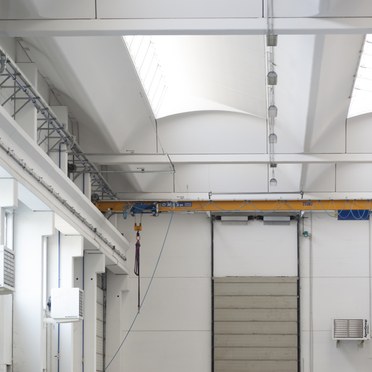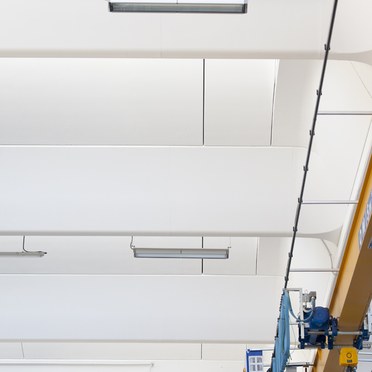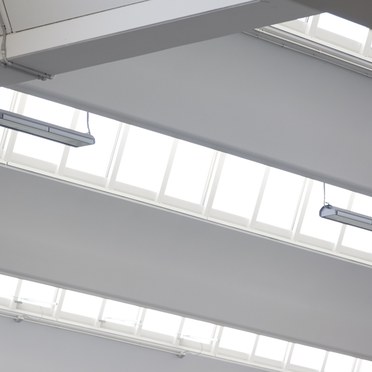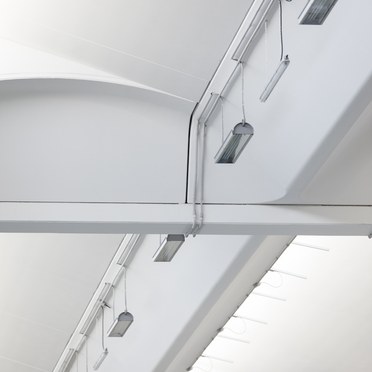Scattolin SpA. Verona, Italy
- Lamp efficacy
Lamp efficacy
Ensuring the lamp efficiently converts electricity into light (lm/W).
- Ballast classification
Ballast classification
Controlling the electricity supply to the lamp (Energy Efficiency Index).
- Luminaire distribution
Luminaire distribution
Controlling light emission using optics which bend and shape the light to the correct location.
- System efficacy
System efficacy
The use of a high efficacy light source combined with precision optics results in a high system efficacy, producing maximum light output for minimum energy input
- Presence/absence detection
Presence/absence detection
Presence: Lights automatically turn on/off with movement. Absence: Lights automatically turn off and must be manually switched on.
- Daylight detection
Daylight detection
The Thorn Titus Industry fittings have built-in daylight sensors that control the dimming function and, delivering lighting energy savings of e20,000 per year compared to the customer’s older lighting
- Constant illuminance
Constant illuminance
A function designed to produce correct light levels for the duration of the maintenance period.
- Task-scene setting
Task-scene setting
Allowing the user to set scenes and adapt the lighting to different tasks.
- Timed off
Timed off
Automatic cut-off can be installed to turn all lights off during unoccupied hours.
- Task lighting
Task lighting
Lighting task areas with the correct amount of light.
- Zoning of lighting
Zoning of lighting
Zoning of lighting: The 116 Titus luminaires are divided into seven groups, covering seven key areas of the building. Each group has a separate sensor and control for dimming, helping the customer maximise the value of daylight and lower their energy costs.
- Maintenance schedule
Maintenance schedule
Maintenance must be performed in response to product age, performance and environment.
- Waste light
Waste light
Eliminating waste light which does not hit the intended target.
- Reflectance
Reflectance
Taking advantage of light which is reflected from the surface within the space.
- Visible smart metering
Visible smart metering
Results of actions can be quickly seen as increased or decreased energy use to encourage responsible energy consumption.
Partnership for business success
Working with Thorn Italy, Studio Tecnico Giovanni Fraccaroli is increasing its business success and helping customers achieve major lighting cost and efficiency savings
Project background
For several years, lighting specialist Studio Tecnico Giovanni Fraccaroli has been working with Thorn Italy to meet its customers' needs. Based on this long and mutually beneficial business relationship, Thorn account manager Marco Bacco, invited the company's founder and managing director Giovanni Fraccaroli, to become a Thorn Energy Partner.
The Thorn Energy Partnership (TEP) is a worldwide venture between Thorn and lighting professionals that promotes energy efficiency without sacrificing good lighting performance. Through the TEP, Giovanni attends training courses, gaining the specialist skills and product knowledge needed to implement world-class energy saving schemes for his customers.
The Thorn Energy Partnership provides a wealth of additional business support for Studio Tecnico Giovanni Fraccaroli. Specifically, Giovanni has ongoing contact with his TEP network leader, who provides in-depth technical consultancy to support bids for new work and helps design efficient lighting schemes for end customers. As an additional benefit, the Studio has a range of business networking opportunities through the TEP.
Recently, the training that Giovanni received in energy efficient solutions delivered major efficiency and cost benefits for a large manufacturer of floats and tippers for commercial vehicles. When the manufacturer established a second production facility at its regional headquarters, it needed a new, highly efficient lighting scheme. After evaluating several proposals, the company chose Studio Tecnico Giovanni Fraccaroli to deliver the required solution.
With high, nine-metre ceilings in its new production facility, the manufacturer needed lighting that was bright enough to meet the needs of managers and workers on the factory floor. In addition, large windows in the walls and ceiling meant that major efficiencies could be achieved using lights that could be dimmed progressively during daylight hours.
The TEP and Studio Tecnico Giovanni Fraccaroli solution
Giovanni Fraccaroli and Thorn Italy worked closely together to scope, design and deliver the most efficient lighting solution for the customer's new, 7,700 square metre production facility. Giovanni says, "The first step was to design a lighting scheme that could provide the right mix of brightness and efficiency. Working with our TEP network leader, we did all the required lighting calculations and came up with the ideal installation for the customer."
The Studio Tecnico Giovanni Fraccaroli solution takes advantage of the latest dimmable fluorescent technology from Thorn. "We designed a lighting scheme based on 116 Thorn Titus Industry luminaires, each housing three 80 watt fluorescent lights," says Giovanni. "Producing uniform illumination from a height of nine metres is a challenging task, but Thorn's high-yield products deliver great results."
Thorn luminaires provide high light output but direct light towards the floor in an efficient way, reducing the overall quantity of fluorescent luminaires needed. "The high light output of Thorn's products is a big reason why we work with them time and time again," says Giovanni. "With lower-quality fittings, we would have needed 20% more lights to get the same results."
The 116 Thorn luminaires are divided into seven groups, covering seven key areas of the building. Each group has a separate sensor and control for dimming, helping the customer maximise the value of daylight and reduce energy costs. "Different areas inside the building receive varying amounts of daylight," says Giovanni. "With Thorn Titus Industry luminaires and the built-in controls, we can set appropriate dimming levels across all areas of the facility and maximise lighting energy efficiency for our customer."
Customer reduces energy costs by €20,000 annually
The partnership between Studio Tecnico Giovanni Fraccaroli and Thorn Italy has delivered impressive efficiency and cost benefits for the end customer. "The new Thorn lighting scheme delivers major energy savings compared to the company's older lighting scheme – which is still in use at their original production facility," says Giovanni. "As a result, the customer will save around €20,000 each year on lighting and achieve full returns on its investment in the new Thorn lighting scheme in just 18 months."
Dimming of lights reduces maintenance requirements and costs
As an additional benefit, the customer will spend less on maintenance for the new lighting scheme, which uses dimming to extend the life of fluorescent tubes. "Because lights will be used to just a fraction of their capabilities in the new facility, they will last much longer, and require far less maintenance," says Giovanni.
Achieving business success in partnership with Thorn Italy
As well as delivering compelling benefits for end customers, membership of the TEP is helping Studio Tecnico Giovanni Fraccaroli to grow and thrive. "With access to the experts at Thorn Italy, we can achieve the perfect balance of lighting efficacy and energy efficiency for our customers," says Giovanni. "The ability to provide innovative, efficient lighting solutions for customers is the cornerstone of our business, and a key success factor in terms of winning new customers."
Thorn Italy is committed to continuing its long-term, mutually beneficial partnership with Studio Tecnico Giovanni Fraccaroli. "We are constantly impressed by the capabilities, skills and experience of Giovanni and his team, and the solutions they deliver are a great showcase for Thorn products such as the Titus Industry luminaires and many others," says Marco Bacco, account manager at Thorn Italy. "We look forward to many more years working together to help end customers maximise their operational efficiency, reduce energy costs, and meet their emissions targets."




